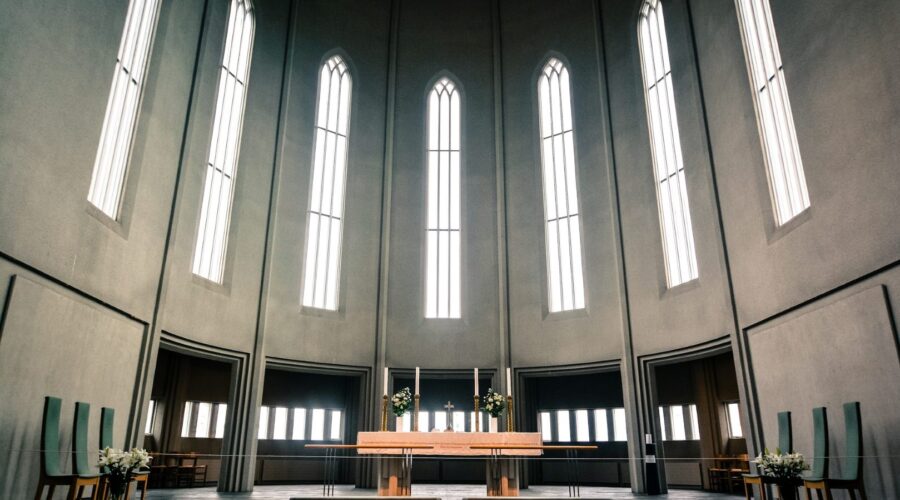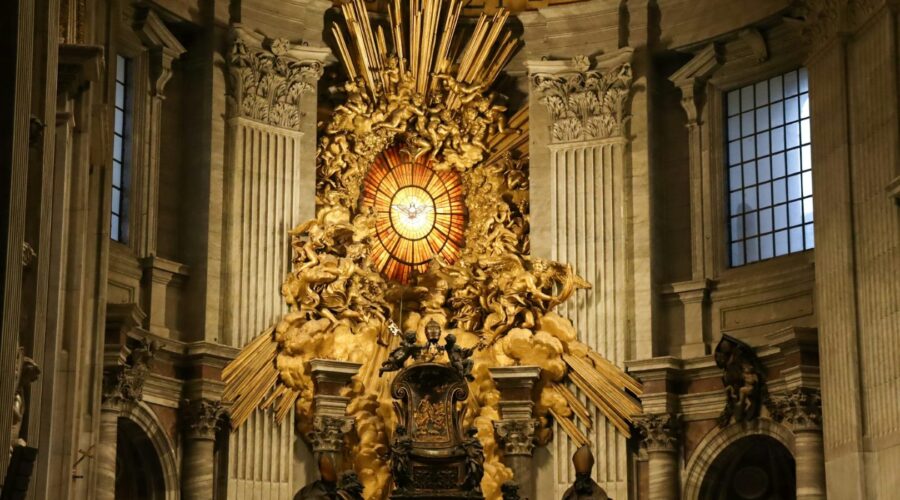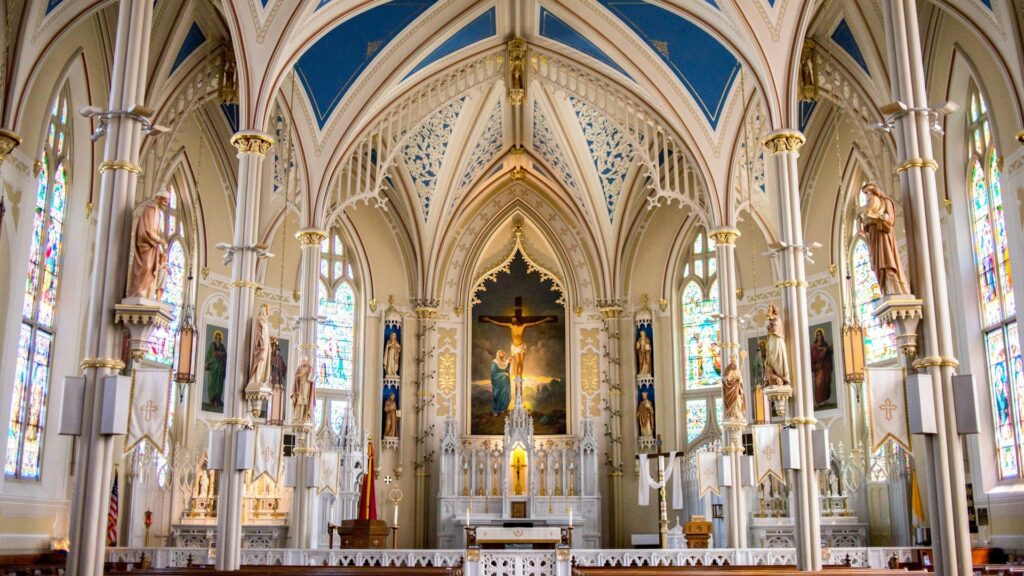Your cart is currently empty!
Blog

Balancing Tradition and Innovation: How Modern Churches Evolve While Honoring Their Roots
In today’s rapidly changing world, churches face the challenge of evolving to meet contemporary needs while preserving their rich traditions. Balancing tradition and innovation is essential for maintaining relevance and fostering growth. In this blog post, we explore how modern churches can successfully navigate this balance, honoring their roots while embracing new approaches to worship and community engagement.
The Importance of Tradition in the Church
Tradition plays a vital role in the life of a church, offering several key benefits:
Connecting to the Past
Traditions provide a link to the church’s history and heritage, connecting current members with generations of believers who have come before. This sense of continuity fosters a deep sense of identity and belonging.
Providing Stability
In an ever-changing world, traditions offer stability and a sense of familiarity. They provide a consistent framework for worship and community life, grounding members in their faith.
Reinforcing Core Values
Traditions reinforce the core values and beliefs of the church. They serve as tangible expressions of the church’s faith and doctrine, helping to preserve its theological integrity.
The Role of Innovation in the Church
Innovation is equally important for the church, offering opportunities for growth and adaptation:
Meeting Contemporary Needs
Innovation allows the church to address contemporary issues and meet the evolving needs of its congregation. By adopting new approaches, the church can remain relevant and responsive to the changing world.
Engaging New Generations
Innovative practices can attract and engage younger generations who may feel disconnected from traditional forms of worship. Embracing technology, modern music, and new forms of outreach can create a more inclusive and engaging environment.
Enhancing Outreach
Innovation can enhance the church’s outreach efforts, enabling it to reach a broader audience. Utilizing social media, live streaming services, and digital resources can expand the church’s impact and accessibility.
Strategies for Balancing Tradition and Innovation
Here are some strategies for modern churches to balance tradition and innovation effectively:
Inclusive Worship Services
Offer a variety of worship services that cater to different preferences. Traditional services can preserve cherished rituals and hymns, while contemporary services can incorporate modern music and technology. This approach ensures that all members feel included and valued.
Embrace Technology
Utilize technology to enhance the worship experience and community engagement. Live streaming services, online Bible studies, and social media outreach can connect members and attract new participants. Ensure that technological innovations complement, rather than replace, traditional practices.
Foster Intergenerational Relationships
Encourage interactions between different generations within the church. Mentorship programs, intergenerational worship services, and mixed-age small groups can foster mutual understanding and respect. These relationships help bridge the gap between tradition and innovation.
Celebrate Heritage, Embrace Change
Celebrate the church’s heritage through special events, historical displays, and educational programs. At the same time, be open to change and experimentation. Create a culture where new ideas are welcomed, and traditions are honored.
Involve the Congregation
Involve the congregation in the process of balancing tradition and innovation. Seek input and feedback from members of all ages and backgrounds. Collaborative decision-making ensures that changes are well-received and reflect the community’s values and needs.
Stories of Successful Balance
Here are a few stories of churches that have successfully balanced tradition and innovation:
St. Mark’s Church: A Blend of Old and New
St. Mark’s Church offers both traditional and contemporary worship services. The traditional service features hymns and liturgy, while the contemporary service includes modern music and multimedia presentations. “We’ve found that offering both options allows us to honor our heritage while reaching new people,” says Pastor John.
Grace Community Church: Embracing Digital Outreach
Grace Community Church has embraced digital outreach, live streaming services, and maintaining an active social media presence. They also hold annual heritage days to celebrate their history and traditions. “Our goal is to be a church that honors the past while looking forward to the future,” explains Communications Director Sarah.
The Impact of Balancing Tradition and Innovation
Balancing tradition and innovation has a profound impact on the church community:
Enhanced Engagement
A balanced approach increases engagement by catering to diverse preferences and needs. Members feel more connected and invested in the church’s mission and activities.
Growth and Vitality
Churches that successfully balance tradition and innovation often experience growth and vitality. They attract new members while retaining long-time congregants, creating a dynamic and vibrant community.
Stronger Community Bonds
Balancing tradition and innovation fosters stronger community bonds. Members appreciate the respect for their heritage and the willingness to adapt, creating a sense of unity and shared purpose.
Conclusion
Balancing tradition and innovation is essential for modern churches seeking to remain relevant and vibrant. By honoring their roots while embracing new approaches, churches can create a dynamic and inclusive environment that meets the needs of all members. Through inclusive worship, technological integration, intergenerational relationships, and collaborative decision-making, churches can successfully navigate this balance and thrive in today’s world.

Embracing Diversity: How Church Communities Can Foster Inclusion and Unity
In today’s world, embracing diversity and fostering inclusion within church communities is more important than ever. By celebrating differences and creating a welcoming environment for all, churches can reflect the true spirit of unity and love. In this blog post, we explore the significance of diversity in the church and offer practical strategies for fostering an inclusive and united community.
The Significance of Diversity in the Church
Diversity within a church community enriches the spiritual experience for everyone. Here’s why diversity matters:
Reflecting God’s Creation
God created humanity with a beautiful array of differences. Embracing diversity within the church mirrors the richness of God’s creation and honors His design.
Broadening Perspectives
A diverse congregation brings together people from different backgrounds, cultures, and experiences. This variety broadens perspectives and deepens understanding, enhancing the church’s ability to address complex issues and serve its community effectively.
Strengthening Community Bonds
When a church values diversity, it strengthens its community bonds by creating an environment where everyone feels seen, heard, and valued. This sense of belonging fosters unity and mutual respect.
Strategies for Fostering Inclusion and Unity
Here are some practical strategies for fostering an inclusive and united church community:
Encourage Open Dialogue
Creating spaces for open dialogue about diversity and inclusion is essential. Encourage members to share their experiences and perspectives, and actively listen to one another with empathy and respect.
Celebrate Cultural Heritage
Celebrate the diverse cultural heritage of your congregation through special events, worship services, and fellowship activities. Highlight different traditions, languages, and customs to promote understanding and appreciation.
Inclusive Worship Practices
Incorporate diverse styles of music, liturgy, and worship practices that resonate with different cultural backgrounds. This inclusivity in worship allows everyone to feel connected and represented.
Diverse Leadership
Ensure that church leadership reflects the diversity of the congregation. Diverse leadership brings a range of perspectives and experiences, fostering a more inclusive decision-making process.
Education and Training
Provide education and training on cultural competency, anti-racism, and inclusion for church staff and members. These programs can raise awareness, challenge biases, and equip the community to be more inclusive.
Stories of Inclusion and Unity
Here are a few stories of church communities successfully embracing diversity and fostering inclusion:
The Multicultural Choir
At St. Andrew’s Church, the formation of a multicultural choir has brought together members from various ethnic backgrounds. Singing in multiple languages and styles, the choir celebrates the diversity of the congregation and enriches the worship experience. “Our choir is a testament to the beauty of unity in diversity,” says the choir director, Maria.
Community Dialogues
First Baptist Church initiated a series of community dialogues on race and inclusion, inviting members to share their stories and listen to others. These dialogues have built bridges of understanding and strengthened the bonds within the congregation. “These conversations have been eye-opening and healing for many of us,” shares participant James.
The Impact of Embracing Diversity
Embracing diversity and fostering inclusion within the church has a profound impact:
Enhanced Spiritual Growth
Diversity challenges individuals to grow spiritually by exposing them to different viewpoints and experiences. This growth leads to a deeper and more mature faith.
Greater Community Outreach
A diverse and inclusive church is better equipped to serve a diverse community. By understanding and respecting different needs and perspectives, the church can extend its reach and effectiveness in community outreach.
A Model of Unity
In a world often divided by differences, a church that embraces diversity serves as a powerful model of unity and love. It demonstrates that despite differences, we are all one in Christ.
Conclusion
Embracing diversity and fostering inclusion are essential for building a vibrant, united church community. By celebrating differences and creating a welcoming environment for all, churches can reflect the true spirit of unity and love. Through practical strategies and a commitment to inclusivity, the church can become a beacon of hope and a model of what it means to be a diverse and unified body of Christ.

Supporting Church Growth: The Role of Small Groups in Building Community
Small groups play a pivotal role in the life of a church, fostering deeper connections and creating a sense of belonging among members. These intimate gatherings provide a space for individuals to grow in their faith, support one another, and strengthen the church community as a whole. In this blog post, we explore the importance of small groups in church growth and how they contribute to building a vibrant, connected congregation.
The Importance of Small Groups
Small groups are essential for several reasons:
Personal Growth
Small groups offer a supportive environment where individuals can discuss their faith, ask questions, and learn from one another. This personalized attention helps members grow spiritually and develop a deeper understanding of their beliefs.
Building Relationships
In a large congregation, it can be challenging to form meaningful connections. Small groups provide a space for members to build strong, lasting relationships with others who share similar interests and values.
Providing Support
Life’s challenges are easier to face with a supportive community. Small groups offer a network of care and encouragement, allowing members to support each other through prayer, advice, and practical help.
Types of Small Groups
There are various types of small groups that cater to different needs and interests within the church. Here are a few common examples:
Bible Study Groups
These groups focus on studying the Bible and discussing its teachings. Participants dive deep into scripture, exploring its meanings and how it applies to their lives today.
Prayer Groups
Prayer groups gather regularly to pray for each other, the church, and broader community concerns. This focused time of prayer strengthens the spiritual bonds among members and provides powerful support.
Interest-Based Groups
Some small groups are formed around common interests or life stages, such as parenting, marriage, or hobbies. These groups allow members to connect over shared experiences and passions while growing in their faith.
Service Groups
Service-oriented groups focus on community outreach and volunteer projects. Members work together on initiatives that benefit the wider community, embodying the church’s mission to serve others.
How Small Groups Foster Church Growth
Small groups contribute to church growth in several key ways:
Increased Engagement
Members who participate in small groups are often more engaged in church activities. These connections make them feel more invested in the church community and its mission.
Enhanced Discipleship
Small groups provide a platform for intentional discipleship, where members can mentor and be mentored. This structured approach to spiritual growth helps develop mature, committed believers.
Stronger Community Bonds
The relationships formed in small groups create a tight-knit community within the larger church body. This sense of belonging encourages members to invite others to join, fostering a welcoming atmosphere for newcomers.
Leadership Development
Small groups are an excellent training ground for future church leaders. Members can take on leadership roles within the group, developing skills and confidence that can be applied to larger church responsibilities.
Stories of Impact
Here are a few stories highlighting the impact of small groups on church members:
Rachel’s Journey: Finding Her Place
Rachel was new to the city and struggling to find her place in a large church. Joining a small Bible study group transformed her experience. “I found a group of friends who supported me and helped me grow in my faith,” she says. “It made a huge church feel like home.”
Tom’s Transformation: From Participant to Leader
Tom started attending a men’s prayer group, seeking support during a difficult time. Over the years, he grew spiritually and took on a leadership role. “Leading the group has been an incredible journey,” Tom shares. “It’s taught me so much about faith and community.”
Getting Involved
If you’re interested in joining or starting a small group, here are a few steps to get started:
- Identify Your Interests: Consider what type of group would best meet your needs and interests, whether it’s a Bible study, prayer group, or interest-based gathering.
- Reach Out: Contact your church’s small group coordinator or pastor to learn about existing groups or how to start a new one.
- Invite Others: Encourage friends, family, and fellow church members to join. The more diverse the group, the richer the experience.
Conclusion
Small groups are a vital component of a thriving church community. They offer personal growth, support, and a sense of belonging, contributing significantly to church growth. By participating in or leading a small group, you can help build a stronger, more connected congregation that supports and nurtures its members.

The Role of Music in Worship: Profiles of Church Choir Members and Musicians
Music has always played a vital role in worship, enriching the spiritual experience and bringing the congregation together in praise. Behind the beautiful harmonies and melodies are dedicated choir members and musicians who offer their time and talents to enhance the worship service. In this blog post, we explore the role of music in worship and profile some of the individuals who make it possible.
The Importance of Music in Worship
Music in worship serves several important functions:
Enhancing the Worship Experience
Music creates an atmosphere that enhances the worship experience, helping congregants to feel more connected to the divine. Hymns, anthems, and contemporary worship songs can evoke powerful emotions and facilitate a deeper sense of spirituality.
Fostering Community
Singing together as a congregation fosters a sense of unity and community. It brings people together, transcending individual differences and creating a shared experience of worship.
Teaching and Reflection
Many hymns and worship songs contain rich theological content that can teach and reinforce the principles of the faith. Through music, congregants can reflect on important spiritual truths in a memorable and meaningful way.
Profiles of Dedicated Choir Members and Musicians
Here are some profiles of choir members and musicians who contribute significantly to the worship experience:
Susan, the Choir Director
Susan has been directing the church choir for over a decade. Under her leadership, the choir has grown in size and skill, performing complex pieces that elevate the worship service. “Music is a powerful way to connect with God and each other,” Susan says. “It’s a privilege to lead such a dedicated group of singers.”
James, the Organist
James has been playing the organ at his church for nearly 20 years. His skillful playing provides a beautiful backdrop for hymns and anthems, creating an atmosphere of reverence and awe. “The organ has a unique ability to fill the sanctuary with sound and lift our hearts in worship,” James shares.
Emily, the Soloist
Emily’s voice has been a staple of the church’s worship services for years. As a soloist, she brings a personal touch to the music, often moving the congregation with her heartfelt performances. “Singing in church is my way of giving back and sharing my gift,” Emily says. “It’s incredibly fulfilling to see how music touches people’s hearts.”
The Youth Band
Comprised of talented young musicians, the youth band brings a fresh and energetic sound to contemporary worship services. Their involvement not only enriches the worship experience but also encourages other young people to participate in church activities. “Playing in the youth band has helped me grow in my faith and connect with my peers,” says Alex, the lead guitarist.
The Impact of Music on the Congregation
The contributions of choir members and musicians have a profound impact on the congregation. Here are a few ways their efforts enhance the worship experience:
Emotional Connection
Music has the power to evoke deep emotions and create a sense of connection. Many congregants find that the music during worship helps them feel closer to God and more engaged in the service.
Encouragement and Inspiration
The dedication and talent of choir members and musicians serve as an inspiration to the congregation. Their commitment to excellence in worship encourages others to participate and contribute their own gifts.
Spiritual Reflection
Through music, congregants have the opportunity to reflect on their faith and the messages being conveyed. The lyrics of hymns and worship songs often resonate with personal experiences and spiritual journeys, providing moments of introspection and growth.
Conclusion
Music plays a crucial role in worship, bringing the congregation together and enhancing the spiritual experience. The dedication of choir members and musicians, like Susan, James, Emily, and the youth band, enriches the worship service and inspires the entire church community. By celebrating their contributions, we acknowledge the power of music in connecting us with the divine and with each other.

Youth in the Church: Nurturing the Next Generation of Believers
The youth are the future of the church, and nurturing their faith is essential for the growth and sustainability of any congregation. By providing meaningful programs and support, churches can help young people develop a strong spiritual foundation. In this blog post, we explore the importance of youth ministry and highlight effective strategies for engaging and supporting the next generation of believers.
The Importance of Youth Ministry
Youth ministry is crucial for several reasons:
Spiritual Growth
Youth ministry helps young people grow in their faith by providing opportunities for learning, worship, and fellowship. Through Bible studies, worship services, and youth retreats, they gain a deeper understanding of their beliefs and how to live out their faith in daily life.
Community and Belonging
For many young people, the church is a place where they can find community and a sense of belonging. Youth programs offer a safe and supportive environment where they can form meaningful relationships with their peers and mentors.
Positive Role Models
Youth ministry provides young people with positive role models who can guide them in their faith journey. Pastors, youth leaders, and older members of the congregation can offer wisdom, support, and encouragement.
Effective Strategies for Youth Ministry
Here are some effective strategies for engaging and supporting the youth in your church:
Relevant and Relatable Programs
Creating programs that are relevant and relatable to young people is key to maintaining their interest and involvement. This could include contemporary worship services, discussions on current issues, and activities that resonate with their interests and experiences.
Leadership Opportunities
Providing leadership opportunities for youth allows them to take ownership of their faith and develop important life skills. Encourage them to lead worship services, organize events, and participate in church committees.
Mentorship Programs
Mentorship programs pair young people with older members of the congregation who can provide guidance and support. These relationships can have a profound impact on the spiritual and personal growth of the youth.
Community Service and Outreach
Involving young people in community service and outreach programs helps them understand the importance of living out their faith through action. These experiences can also deepen their connection to the church and the broader community.
Creating a Safe and Inclusive Environment
It’s essential to create a safe and inclusive environment where all young people feel welcome and valued. This includes being mindful of diversity and ensuring that all programs and activities are accessible and inclusive.
Inspirational Stories of Youth in Action
Here are a few stories of young people making a difference in their church communities:
Anna’s Initiative: A Youth-Led Food Drive
Anna, a high school student, noticed an increase in food insecurity in her community. With the support of her youth group, she organized a food drive that collected thousands of pounds of food for local families in need. “I wanted to show that even young people can make a big difference,” Anna says.
Michael’s Mission: Peer Mentoring Program
Michael, a college student, started a peer mentoring program to support younger students in their faith journey. By pairing high school students with college mentors, the program provides guidance and fosters strong, supportive relationships. “It’s amazing to see how much both the mentors and mentees grow through this experience,” Michael shares.
Conclusion
Youth ministry plays a vital role in nurturing the next generation of believers. By providing relevant programs, leadership opportunities, mentorship, and a safe, inclusive environment, churches can support young people in their faith journey and ensure the continued growth and vitality of their congregation. Celebrating and sharing the stories of young people in action can inspire others and highlight the positive impact of youth ministry.

From the Pulpit to the People: How Pastors and Priests Connect with Their Congregations
The role of pastors and priests extends far beyond delivering sermons on Sundays. These spiritual leaders play a crucial part in fostering a sense of community, providing support, and building meaningful connections with their congregations. In this blog post, we explore the various ways pastors and priests engage with their church members and the impact of these connections.
The Many Roles of Pastors and Priests
Pastors and priests wear many hats in their efforts to connect with their congregations. Their responsibilities include:
Spiritual Guidance
Pastors and priests provide spiritual guidance through their teachings, sermons, and personal interactions. They help individuals navigate their faith journeys, offering wisdom and support during times of doubt or crisis.
Pastoral Care
Pastoral care is a vital aspect of a pastor’s or priest’s role. This involves visiting the sick, comforting those who are grieving, and providing counseling to individuals and families. By being present during life’s most challenging moments, they offer a sense of hope and reassurance.
Community Engagement
Engaging with the broader community is another important duty. Pastors and priests often participate in community events, support local charities, and collaborate with other organizations to address social issues. Their involvement helps bridge the gap between the church and the community.
Building Personal Connections
Personal connections are at the heart of effective pastoral care. Here are some ways pastors and priests build these connections:
One-on-One Meetings
Pastors and priests often schedule one-on-one meetings with congregation members to discuss personal issues, offer spiritual advice, or simply get to know them better. These meetings provide an opportunity for deeper, more meaningful conversations.
Small Group Gatherings
Hosting small group gatherings, such as Bible study groups, prayer meetings, or fellowship groups, allows pastors and priests to engage with church members in a more intimate setting. These gatherings foster a sense of community and belonging among participants.
Social Media and Technology
In today’s digital age, many pastors and priests use social media and technology to stay connected with their congregations. They share inspirational messages, provide updates on church activities, and offer virtual pastoral care. This approach ensures that they remain accessible, even to those who may not attend services regularly.
The Impact of Strong Connections
Strong connections between pastors, priests, and their congregations have a profound impact on the church community. These connections:
Foster Trust
When congregation members feel that their spiritual leaders genuinely care about them, it fosters trust and strengthens the community bond. This trust encourages openness and honesty, creating a supportive environment.
Encourage Participation
When pastors and priests actively engage with their congregation, it motivates members to participate more fully in church activities and outreach programs. This increased participation enhances the vibrancy and vitality of the church community.
Provide Emotional Support
The personal connections formed through pastoral care offer essential emotional support. Congregation members know they have someone to turn to during difficult times, which can significantly impact their overall well-being and faith journey.
Conclusion
Pastors and priests play a vital role in connecting with their congregations. Through spiritual guidance, pastoral care, community engagement, and personal connections, they build strong, supportive church communities. By understanding and appreciating these efforts, we can better support our spiritual leaders and strengthen the bonds within our church.

Faith in Action: Inspirational Stories of Church Members Making a Difference
In every church, there are individuals whose acts of kindness and service extend beyond the walls of the sanctuary, touching lives and making a profound impact on the community. These church members embody the true spirit of faith in action. In this blog post, we share their inspiring stories and explore how their efforts are making a difference.
The Power of Faith in Action
Faith in action is about more than attending church services; it’s about living out one’s faith through acts of service, compassion, and love. When church members engage in outreach and charitable activities, they exemplify the teachings of their faith and inspire others to do the same.
Stories of Church Members Making a Difference
Here are some inspirational stories of church members who have taken their faith beyond the pews to make a tangible difference in their communities:
Maria’s Mission: Feeding the Hungry
Maria has always felt a calling to help those in need. She started a weekly soup kitchen at her church, providing hot meals to the homeless and those struggling to make ends meet. “It’s not just about the food,” Maria explains. “It’s about showing people that they are loved and cared for. We all need a little help sometimes.”
David’s Dedication: Mentoring Youth
David, a longtime church member, noticed a growing number of at-risk youth in his community. In response, he started a mentorship program through his church, pairing young people with positive role models. “These kids need guidance and someone to believe in them,” David says. “Seeing them grow and succeed is incredibly rewarding.”
Emma’s Effort: Supporting Refugees
Emma felt moved to help refugees resettling in her city. She organized a team of volunteers from her church to assist with housing, job placement, and language classes. “Our faith calls us to welcome the stranger,” Emma shares. “These families have been through so much. It’s our duty to help them rebuild their lives.”
The Ripple Effect of Good Deeds
The acts of service performed by church members often create a ripple effect, inspiring others to get involved and make a difference. These stories of faith in action encourage more people to step up and contribute to their communities, fostering a culture of compassion and generosity.
How to Get Involved
If you feel inspired by these stories and want to put your faith into action, there are many ways to get involved. Here are a few steps you can take:
- Identify a Need: Look for areas in your community where help is needed, such as food insecurity, homelessness, or youth mentorship.
- Start Small: Begin with small acts of kindness or join existing programs and initiatives within your church.
- Volunteer Your Time: Offer your time and skills to local charities, shelters, and community centers.
- Form a Group: Gather like-minded individuals from your church to start a new outreach program or support an existing one.
Conclusion
The stories of church members making a difference through their acts of service are a powerful testament to the impact of faith in action. By sharing these inspirational stories, we hope to encourage others to follow their example and bring positive change to their communities. Together, we can create a world where compassion, kindness, and love prevail.

The Unsung Heroes: Celebrating the Volunteers Behind Church Events
In every church community, there are individuals who work tirelessly behind the scenes to ensure that events run smoothly and successfully. These volunteers, often unnoticed and uncelebrated, are the backbone of many church activities. In this blog post, we shine a spotlight on these unsung heroes, exploring their invaluable contributions and sharing their inspiring stories.
The Importance of Church Volunteers
Church volunteers play a crucial role in the life of the church. From organizing events to assisting with day-to-day operations, their efforts are essential to the church’s mission and outreach. Without their dedication, many programs and activities simply would not be possible.
The Diverse Roles of Church Volunteers
Volunteers in the church take on a wide range of responsibilities. Here are a few key areas where their contributions make a significant impact:
- Event Planning and Coordination: From holiday celebrations to charity fundraisers, volunteers are often the driving force behind church events. They handle logistics, coordinate schedules, and ensure everything runs smoothly.
- Hospitality and Welcome Teams: These volunteers create a warm and welcoming environment for newcomers and regular attendees alike. They greet visitors, provide information, and help integrate new members into the church community.
- Children’s Ministry: Many volunteers dedicate their time to teaching and caring for the youngest members of the church. Their efforts in Sunday school classes and youth programs are vital to nurturing the faith of the next generation.
- Music and Worship: Choir members, musicians, and worship leaders often volunteer their time and talents to enhance the worship experience. Their contributions add depth and richness to church services.
Inspiring Stories from Church Volunteers
To truly understand the impact of church volunteers, it’s important to hear their stories. Here are a few inspiring examples from volunteers who have made a difference in their church communities:
Sarah’s Story: The Event Planner Extraordinaire
Sarah has been a member of her church for over 20 years. She started volunteering as an event planner five years ago and has since coordinated countless events, from holiday dinners to community outreach programs. “Volunteering allows me to give back to the community that has given so much to me,” she says. “Seeing the joy and connection these events bring to people makes it all worthwhile.”
John’s Story: The Welcoming Greeter
John, a retiree, volunteers as part of the church’s welcome team. Every Sunday, he greets attendees with a smile and a warm handshake. “Being a welcoming presence is important,” John explains. “It helps people feel at home and part of the church family. I’ve met so many wonderful people through this role.”
The Impact of Volunteer Work on the Church Community
The contributions of volunteers extend far beyond the tasks they perform. Their work fosters a sense of community, support, and belonging within the church. Volunteers build connections, strengthen relationships, and create an environment where everyone feels valued and loved.
How to Get Involved
If you feel inspired by these stories and want to contribute to your church community, consider volunteering. There are numerous opportunities available, and your unique skills and talents can make a significant difference. Reach out to your church’s volunteer coordinator or visit their website to learn more about how you can get involved.
Conclusion
Church volunteers are the unsung heroes who dedicate their time, energy, and passion to making their church a vibrant and welcoming place. Their contributions are invaluable, and their stories are truly inspiring. By celebrating and recognizing their efforts, we can encourage more people to step forward and experience the joy and fulfillment that comes from serving their church community.

The Evolution of Church Architecture: From Ancient to Modern Times
Church architecture has evolved significantly over the centuries, reflecting changes in religious practices, cultural influences, and technological advancements. From the grandeur of ancient basilicas to the simplicity of modern churches, each architectural style tells a story of the time in which it was built. In this blog post, we will explore the fascinating evolution of church architecture, highlighting key styles and their defining characteristics.

1. Early Christian Architecture
Historical Background
Early Christian architecture, dating from the 4th to the 6th centuries, marked the beginning of church building as we know it today. With the legalization of Christianity under Emperor Constantine, Christians were able to construct large public places of worship.
Key Features
- Basilica Plan: Early churches were often modeled after Roman basilicas, featuring a rectangular layout, a central nave flanked by aisles, and an apse at one end.
- Simple Exteriors: The exteriors were typically plain, with little decoration, reflecting the early Christian emphasis on inner spiritual life.
- Mosaics and Frescoes: Interiors were adorned with religious mosaics and frescoes, depicting biblical scenes and saints.

2. Romanesque Architecture
Historical Background
Romanesque architecture emerged in the 10th century and lasted until the 12th century. This style is characterized by its massive quality, thick walls, and sturdy construction, which were practical for the tumultuous times of the early medieval period.
Key Features
- Rounded Arches: Romanesque churches are known for their rounded arches, both in windows and doorways.
- Barrel Vaults: The use of barrel vaults and groin vaults allowed for stronger and more fire-resistant roofs.
- Thick Walls and Small Windows: These features provided the necessary support for heavy stone roofs and created a sense of solidity and fortification.
- Decorative Elements: Sculpture and relief carvings depicting biblical stories and symbolic motifs were common around doorways and capitals.

3. Gothic Architecture
Historical Background
Gothic architecture developed in the 12th century and flourished until the 16th century. It represented a shift towards more vertical and light-filled structures, aiming to inspire awe and draw the eyes heavenward.
Key Features
- Pointed Arches: The use of pointed arches allowed for greater height and more complex structures.
- Ribbed Vaults: Ribbed vaults distributed the weight of the roof more efficiently, enabling the construction of taller and more elaborate buildings.
- Flying Buttresses: External supports called flying buttresses allowed for thinner walls and larger windows.
- Stained Glass Windows: Large stained glass windows, often depicting biblical narratives, flooded the interiors with colorful light.
- Ornate Facades: The facades of Gothic churches were highly decorative, featuring intricate stone carvings, gargoyles, and statues of saints.

4. Renaissance and Baroque Architecture
Historical Background
The Renaissance (14th to 17th centuries) and Baroque (17th to 18th centuries) periods brought new styles influenced by classical antiquity and the desire for dynamic, expressive designs.
Key Features of Renaissance Architecture
- Symmetry and Proportion: Renaissance churches emphasized balance, symmetry, and proportion, drawing inspiration from the architecture of ancient Rome and Greece.
- Domes and Columns: The use of domes, columns, and pilasters became prominent, often combined with classical pediments and entablatures.
- Geometric Layouts: Church layouts often featured centralized plans or modified basilica plans, with an emphasis on harmony and clarity.
Key Features of Baroque Architecture
- Dramatic and Theatrical: Baroque architecture is characterized by its dramatic use of light and shadow, elaborate decorations, and a sense of movement.
- Curved Forms: The use of curves, ovals, and dynamic shapes created a sense of fluidity and grandeur.
- Ornamentation: Lavish ornamentation, including stucco, frescoes, and gilded details, enhanced the visual impact of Baroque churches.

5. Modern Church Architecture
Historical Background
Modern church architecture, emerging in the 20th century, reflects changes in liturgical practices, technological advancements, and new aesthetic sensibilities. Architects began to experiment with new materials and forms, leading to innovative and diverse designs.
Key Features
- Simplified Forms: Modern churches often feature clean lines, simple forms, and minimal ornamentation, focusing on function and spirituality.
- Innovative Materials: The use of new materials, such as steel, glass, and reinforced concrete, allowed for greater flexibility in design.
- Natural Light: Emphasis on natural light and openness, often achieved through large windows and skylights, creates a sense of connection with the outside world.
- Functional Spaces: Modern churches are designed to accommodate various functions, including worship, community activities, and social services.
Conclusion
The evolution of church architecture is a testament to humanity’s enduring quest to create spaces that inspire, uplift, and connect us to the divine. From the sturdy Romanesque structures to the awe-inspiring Gothic cathedrals and the innovative modern designs, each architectural style reflects the values, beliefs, and technological capabilities of its time. Exploring these architectural masterpieces offers not only a glimpse into the past but also an appreciation for the creativity and devotion that continue to shape our sacred spaces.